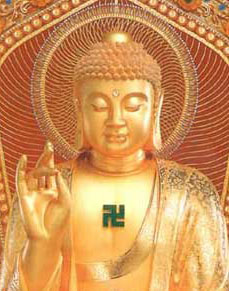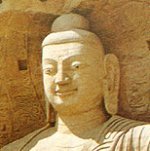
The very main Buddhist Religious symbols are "卍" or "卐", which are called swastika in English and called Sanskrit in ancient Indian language.
The swastika symbols can be found in the archaeological findings in all over the world including in Europe, Asia, and America etc. These relics show that the swastika symbols really have a long history in human world. In the modern times, swastika symbols have been adopted and applied by football team, society groups, fashion designers etc, so they are often seen in everyday life.[1]
 |
| The very origin of swastika symbol is that it is a mark on Buddha's body. |
|
Get meaningful Chinese name for westerners
|
Generally, people regard that swastika symbols mean "good fortune", but most people have forgotten the very original meaning of the symbols. The very origin of swastika symbols is not from human world but from Buddha's paradise. It is a mark on Buddha's body that represents the Buddha's level and status in heaven. A Buddha of Tathagata level only has one swastika on the body, while higher level Buddhas have more swastika symbols. Arhats and Budhisattvas do not have any swastika on their bodies. We can find one swastika on many Buddha statues' chests.
 Swastika symbols found in Ancient Greek culture. |
The Buddhist Religious symbols – Swastika can be also found in the Ancient Greek cultural relics found in Europe. [2]
Actually in the early historical times before the Big Flood, the people in Europe also believed in Buddha.
During the Big Flood, some ancient Greek people who lived to the south-west of Himalayas Mountain survived. They are the current white-skin Indians and were called Brahmans at that time. Originally in Brahmanism, people believed in Buddha, which was the inheritance of the Buddha belief of ancient Greek people.
They also inherited the sculpturing methods from Ancient Greece. So the ancient Indian Buddha statues were in Ancient Greek style. This sculpture art also spread from India into China together with Buddhism. So you will find some Asian Buddha statues having deep eyes and straight nose. The eyebrow outline and facial outline of the statues are just like western people's outline.
 One of the main Buddha statues in Yun-gang Grotto, Shan-xi Province,China assumes an obvious western face outline. |
In about 500 B.C., Shakyamuni came to the world and started to preach his teachings. Now when we say Buddhism, in a narrow sense, it just refers to the specific religion of Shakyamuni's teaching. The Buddhism spread to China in the 1st century and has become one of the major religions of Chinese people.
However, in a broad sense, Buddhism is not limited to referring to the belief in Shakyamuni. For example, Tibetan Tantrism also believed in Buddha but not Shakyamuni. In China, people regard Tibetan Tantrism as part of Buddhism. Actually, Tantrism was not created by Shakyamuni and in some divisions of Tantrism the followers did not know Shakyamuni at all.
Even within Chinese Buddhism, there are several Tathagatas and Budhisattvas being worshiped. (Tathagata is the title of Buddha just like human's job title.) Shakyamuni himself says Tathagatas in the universe are as many as the sands in Ganges River.
Therefore, Buddha is the general word for a type of divine beings in heaven. They assume an outlook of blue hair of curls and wrap the body with a long yellow cloth. And swastika is a mark on Buddha's body.
The Nazi symbol vs. Buddhist symbol
As you see, the Buddhist religious symbols swastika has a much longer history in human world than the Nazi symbols. Hitler stole the Buddhism symbol, but he was using the symbols differently. In Buddhism, the swastika is put flat and not in black color, but the Nazi put the swastika's corner pointing upwards and made it black. | ||
|
References: [1] http://www.swastika-info.com/ ; "The True Legends of Swastika" : A poster of a collection of swastika symbols found in all over the world. [2] Heinrich Schliemann; "The City and Country of the Trojans"; 1881, pp 291,292,425-. |